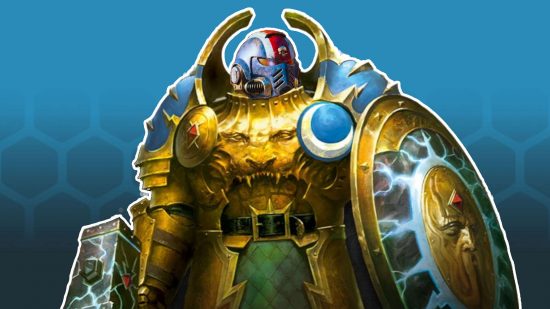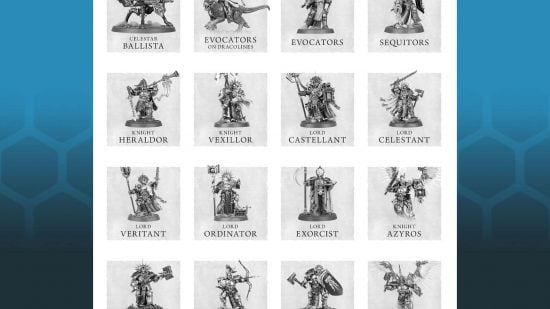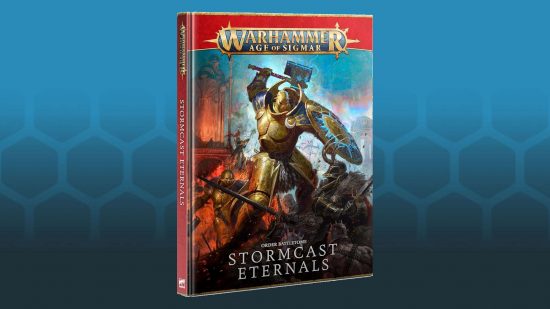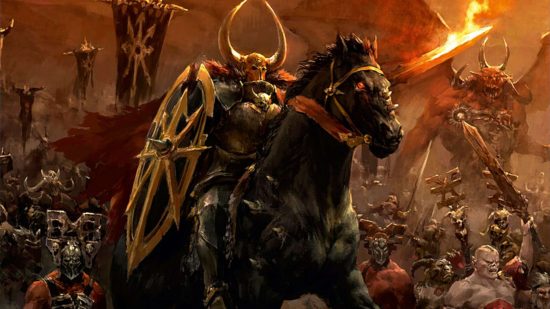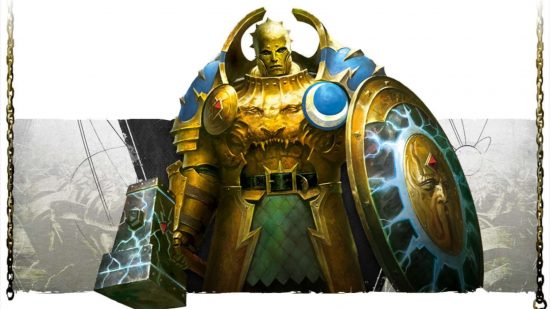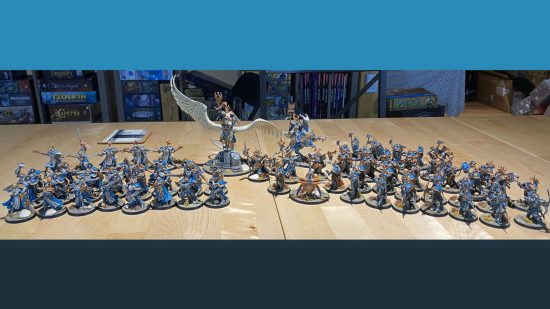On Thursday, Games Workshop announced that 23 Stormcast Eternals model kits were set to leave production, a huge tranche of the model line including the entire Sacrosanct chamber and many named characters. It’s a blow for enfranchised collectors, and a humiliating defeat for the Stormcast in their most important mission: to act as Age of Sigmar’s Space Marines.
The Stormcast Eternals are the face of Age of Sigmar, appearing as one of the two forces in every starter set since 2015. They’re at the centre of the game’s marketing, the most common protagonists in Age of Sigmar novels and Warhammer+ animations, and feature in introductory products like Warhammer board games and Stormbringer magazine. But being the most heavily marketed Age of Sigmar army hasn’t given them the popularity needed to sustain a massive model range.
In a Warhammer Community post announcing the range reduction – which includes a total of 82 kits across a variety of factions – Games Workshop states that “as we make new models, and new books to explore their background and rules, we have to stop producing and featuring some older models”. Let’s break down that claim.
First: GW absolutely does need to release new kits if it wants to sustain its current level of profitability. The bulk of tabletop game sales are from new products (with the exception of a few classic board games, and stuff like paints for miniatures that are always useful). Nerds just love novelty. Redesigns to classic kits do sell – and we know that some of the outgoing Stormcast kits will return, like the revamped Liberators – but brand new kits usually sell better.

What about keeping old products in production? Games Workshop has several advantage over other manufacturers that put it in a better position to do this.
A very large product range can be difficult for independent retailers to stock or distributors to administrate effectively, but this a problem Games Workshop has mastered: it has an established system for retailers to order back catalogue items as they need them, and an international webstore for customers to order exactly what they want.
There’s also very little cost to Games Workshop to make more copies of an old plastic kit. Most of the cost for making plastic minis is upfront, designing the models, then creating the casting tools: GW spent over $8 million on molds in 2022-23 alone. But the cost of plastic, the electricity in the factory, and the salary of the person who runs the casting machine don’t add up to much at all for each sprue.
Maintaining and balancing rules for a large model range is a challenge for miniature wargames designers. Certainly, the Stormcast Eternals battletome is bursting with Warscrolls in AoS 3rd edition, with lots of repetition – there is a good case to cull it to make it more manageable. But turning multiple kits into aesthetic variants of a single unit would let GW keep selling the minis, while reducing the space they take in the rulebook.
More to the point, I don’t believe that the rules design team has the deciding vote on what models do or don’t stay in production. The Space Marines Warhammer 40k Codex is colossal and packed with units that fill extremely similar niches, and it has only slowly shed kits across multiple editions – because Space Marines always sell.
GW doesn’t mention it, but it has even incurred a cost by removing so many minis from production simultaneously. Fans are unhappy that their models are losing official rules support, and cautious fans will think twice about investing time and money into new armies.
We know that Games Workshop is content to disappoint established customers when it thinks that’s the correct business choice – Archaon blowing up the Warhammer Fantasy world was deeply unpopular with long-term fans. But that doesn’t mean it makes this kind of decision if it can’t see a benefit to doing so. There’s something on the other side of the balance sheet that makes up for damaging consumer confidence like this.
The real cost of keeping plastic kits in production is opportunity cost. Offering a model to customers and distributors means dedicating factory shifts to making it and packaging it up, and then giving it space in the warehouse. A product that sits in the warehouse without selling is effectively shrinking your warehouse – not something Games Workshop wants, when it sometimes struggles to meet demand for its most hotly anticipated releases.
What does this tell us about the Stormcast cull? Though some of the first generation Stormcast models will return with revamped minis, just about every Stormcast mini released during the game’s second edition has gone. It’s a huge layoff of very recent miniatures, and my conclusion is simple – they’re not selling.

Some of that will be because the market is glutted with second hand models. The Sacrosanct chamber featured in the second edition Age of Sigmar starter sets, and then stuck to the front of Mortal Realms magazine. Yet equivalent factors haven’t led to a grand reduction in the Primaris Space Marines line. As I said before, Space Marines always sell. Which gets to the heart of the problem – the Stormcast have been sent to do a Space Marine’s job.
This article isn’t about to turn into Stormcast bashing. I think the lore for Stormcast is excellent, and some of their miniatures are exceptional. While their superheroic proportions and clean aesthetic are a massive break from Warhammer tradition, a factor in their rocky reception among Warhammer fantasy fans when they launched in 2015, they give Age of Sigmar a range of easy-to-paint miniatures that are great for newcomers.
What they are not, however, is fantasy Space Marines, and it’s obvious that’s what Games Workshop wanted them to be. The core of their lore is built on similar themes: elite warriors plucked from their home culture and elevated to superhuman stature who face an eternity of war, slowly losing connection with humanity in order to protect it.
Aesthetically, they wear similar full-body armor suits with full helms and massive pauldrons. They’re used in exactly the same types of marketing material, standing in exactly the same poses, as the Space Marines are to promote their respective games. The firm even made a Stormcast Eternals Liberator statue to face off against Jes Goodwin’s decades-old Space Marine in the Warhammer World carpark.
There’s nothing wrong or foolish about trying to repeat the success of the Space Marines by transposing elements of their design to a fantasy context. And who wouldn’t want another pop-culture hit like the Space Marines? Space Marines always sell: new kits and old kits, to newcomers and old-timers. You can currently buy three Horus Heresy tactical squads that are distinguished purely by the mark of Space Marine armor they wear, one of which is older than the outgoing Stormcast, and people buy them all.

Why the Space Marines are so popular would take a book, let alone another article, to explain. The early GW artists, mini designers, and rules writers brought their vision of a superhuman space soldier out at just the right moment to catch the cultural zeitgeist. Other creators have built on that design for decades, giving it an incredible complexity and richness.
No amount of effort or planning could guarantee that the Stormcast Eternals would succeed like the Space Marines: Games Workshop was trying to catch lightning in a bottle. It has failed.
If GW has made an avoidable mistake here, it was growing the Stormcast Eternals range as fast and as wide as it did. Perhaps it made sense at the time, but now – as the firm retires dozens of kits, some less than six years old – it looks like hubris.
Treating the Stormcast like Space Marines was not enough to make them as popular as Space Marines. The outgoing Sacrosanct models are pretty good – some, like Aventis Firestrike, are absolutely cracking. But Space Marines? Space Marines are something else.
Wargamer sympathises with anyone who feels deeply frustrated their army is no longer valid in tournament games. Redditor Aietos shared this photo of a beautifully painted Stormcast army in the r/ageofsigmar subreddit, none of which will have rules in the next Battletome (though they will receive Legends rules). Just fifteen models in his collection remain untouched.
If you want to use the same minis in a different game, we can recommend some other great fantasy wargames, many of which can use any miniatures you like. Or if you plan to join Age of Sigmar 4th edition with a new army, we’re reporting on the AoS 4e rules changes as they’re announced.
